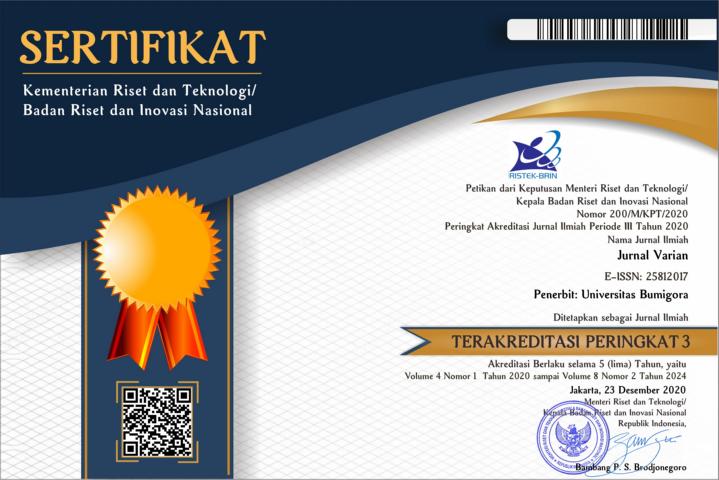Application of Artificial Neural Network in Predicting Direct Economic Losses Due to Earthquake
DOI:
https://doi.org/10.30812/varian.v7i1.2326Keywords:
Direct Economic Losses, Interpolation, Backpropagation, Neural NetworkAbstract
Accurately predicting the direct economic losses caused by earthquakes is important for policy makers for disaster budgets. Before a disaster strikes, it is important to consider the public policy costs associated with disaster relief and recovery. The aim of this study is to provide a risk assessment approach, which can benefit all parties involved. Artificial neural networks are widely used for time series forecasting, especially financial forecasting. Therefore, this study proposes a cutting-edge forecasting method such as backpropagation neural network (BPNN) and other prediction methods: neural network autoregressive (NNAR) and ARIMA-GARCH to obtain the best prediction results. This paper applies interpolation data to increase the amount of data used. Two interpolations were applied to amplify the original small sample with virtual points, namely cubic splines and further piecewise interpolation using. The results of this study are the cubic spline interpolation is the most effective way to solve the small sampling problem to predict direct economic losses due to the Indonesian earthquake and the BPNN method outperforms other traditional methods with an RMSE of 0.024 in the training period and 0.174 in the testing period, significantly lower than other methods. The results of this research can be used as reference material for the government in estimating the level of earthquake losses and can be used to develop risk reduction strategies.
References
Academic Journal of Nawroz University, 8(4):216–221. doi: https://doi.org/10.25007/ajnu.v8n4a464.
Azmi, U., Soehardjoepri, S., and Putri, I. M. H. (2022). Application of neural network autoregression (nnar) and arima-garch based
on interpolation for forecasting direct economic losses of earthquake in indonesia. In AIP Conference Proceedings, volume 2641.
AIP Publishing. doi: https://doi.org/10.1063/5.0115889.
Bai, Y., Li, Y., Wang, X., Xie, J., and Li, C. (2016). Air pollutants concentrations forecasting using back propagation neural
network based on wavelet decomposition with meteorological conditions. Atmospheric pollution research, 7(3):557–566. doi:
https://doi.org/10.1016/j.apr.2016.01.004.
Hartono, D., Apriyadi, R. K., Winugroho, T., Aprilyanto, A., Sumantri, S. H., Wilopo, W., and Islami, H. S. (2021). Analisis sejarah,
dampak, dan penanggulangan bencana gempa bumi pada saat pandemi covid-19 di sulawesi barat. PENDIPA Journal of Science
Education, 5(2):218–224. doi: https://doi.org/10.33369/pendipa.5.2.218-224.
Hayuningtyas, R. Y. and Sari, R. (2021). Aplikasi peramalan alat kesehatan menggunakan single moving average. Jurnal Infortech,
3(1):40–45. doi: https://doi.org/10.31294/infortech.v3i1.10397.
Lusiana, A. and Yuliarty, P. (2020). Penerapan metode peramalan (forecasting) pada permintaan atap di pt x. Industri Inovatif: Jurnal
Teknik Industri, 10(1):11–20. doi: https://doi.org/10.36040/industri.v10i1.2530.
Meilano, I., Virtriana, R., Atmaja, F. W., and Zulfakriza, Z. (2022). GEMPA BUMI DI INDONESIA Aspek Spasial dan Kerugian
Ekonomi Bencana. ITB PRESS.
Monsalve-Giraldo, J., Cortina, J. P., de Sousa, F. J., Videiro, P. M., and Sagrilo, L. V. (2018). Hybrid parabolic interpolation–
artificial neural network method (hpi-annm) for long-term extreme response estimation of steel risers. Applied Ocean Research,
76:221–234. doi: https://doi.org/10.1016/j.apor.2018.05.008.
Rais, L. N. (2021). Analisis bencana gempa bumi dan mitigasi bencana di daerah kertasari. Jurnal Samudra Geografi, 4(2):14–19.
Rao, Z.-q. and Yang, C.-j. (2017). Numerical prediction of effective wake field for a submarine based on a hybrid approach and an
rbf interpolation. Journal of Hydrodynamics, 29(4):691–701. doi: https://doi.org/10.1016/S1001-6058(16)60781-3.
Requia, W. J., Coull, B. A., and Koutrakis, P. (2019). Evaluation of predictive capabilities of ordinary geostatistical interpolation,
hybrid interpolation, and machine learning methods for estimating pm2. 5 constituents over space. Environmental research,
175:421–433. doi: https://doi.org/10.1016/j.envres.2019.05.025.
Utomo, D. D. and Marta, F. Y. D. (2022). Dampak bencana alam terhadap perekonomian masyarakat di kabupaten tanah datar. Jurnal
Terapan Pemerintahan Minangkabau, 2(1):92–97. doi: https://doi.org/10.33701/jtpm.v2i1.2395.
Yu, H.-K., Kim, N.-Y., Kim, S. S., Chu, C., and Kee, M.-K. (2013). Forecasting the number of human immunodeficiency virus
infections in the korean population using the autoregressive integrated moving average model. Osong public health and research
perspectives, 4(6):358–362. doi: https://doi.org/10.1016/j.phrp.2013.10.009.
Zhang, Y., Li, W., Chen, Q., Pu, X., and Xiang, L. (2017). Multi-models for spi drought forecasting in the north of haihe river basin,
china. Stochastic environmental research and risk assessment, 31:2471–2481. doi: https://doi.org/10.1007/s00477-017-1437-5.
Zhao, X., Li, H., Ding, L., and Liu, M. (2019). Research and application of a hybrid system based on interpolation for forecasting
direct economic losses of marine disasters. International Journal of Disaster Risk Reduction, 37:101121. doi: https://doi.org/10.
1016/j.ijdrr.2019.101121.
Downloads
Published
Issue
Section
How to Cite
Most read articles by the same author(s)
- Wawan Hafid Syaifudin, Ulil Azmi, Aplikasi Model Predictive Control (MPC) Pada Optimasi Portofolio Komoditas , Jurnal Varian: Vol. 3 No. 2 (2020)
- Ulil Azmi, Wawan Hafid Syaifudin, Peramalan Harga Komoditas dengan Menggunakan Metode Arima-Garch , Jurnal Varian: Vol. 3 No. 2 (2020)
- Galuh Oktavia Siswono, Ulil Azmi, Wawan Hafid Syaifudin, Mortality Projection on Indonesia's Abridged Life Table to Determine the EPV of Term Annuity , Jurnal Varian: Vol. 4 No. 2 (2021)





















